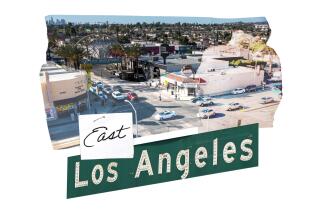Some Steps to Stopping the Sprawl of Suburbia
Awhile back I wrote a column on “mall sprawl.” Many people wrote to say they shared my concerns about the rampant overdevelopment of our communities.
I heard the same stories again and again about small towns and neighborhoods fighting losing battles against moneyed developers and giant retail chains.
All over the country, the mantra “grow or die” has been inflicted on communities, as if infusing the landscape with more Kmarts and Home Depots is the key to revitalization. However, the evidence is mounting that growth does not necessarily equal prosperity.
According to a major report published by the Sierra Club in September 1998, titled “The Dark Side of the American Dream: The Costs and Consequences of Suburban Sprawl,” overdevelopment in the suburbs has created severe problems. These include increased traffic jams, rising costs of public services, wasted tax revenue, higher levels of air and water pollution, and the loss of prime farmland.
The Sierra Club ranks Atlanta as the worst city for sprawl, losing some 500 acres of farmland, forest and green space each week. Other problem cities, according to the report, include Cincinnati, Denver, Seattle and Fort Lauderdale.
Can we stop the sprawl? The elections last November offered a glimmer of hope. In about 200 state and local ballot initiatives involving sprawl, the voters said, in effect, that they were taking back the land by committing over $7 billion to the task of preservation and responsible urban revitalization.
For example, New Jersey residents approved a constitutional amendment that allots up to $98 million annually for preservation and open-space conservation. Roy Barnes, the newly elected governor of Georgia, campaigned on an antisprawl platform, and one of his first official acts was to introduce a bill that would limit development in the Atlanta metropolitan area. Called the Regional Transportation Act, the bill passed the Georgia Legislature in March.
Fighting overdevelopment is very much a local affair. Citizen groups do have power. One such group, 1000 Friends of Oregon, has successfully forced the state to create urban growth boundaries in every city and town.
The sustainable Loudon Network is a group of citizens that ensures that new development in Loudon County, Va., is fiscally, environmentally and socially responsible.
CAUSE (Citizens Against Urban Sprawl Everywhere) began as a group of neighbors and businesses that joined together to combat overdevelopment in Durham, N.C., and has now expanded to lobby against growth in other areas.
There are many other examples. You can find out about efforts in your own area through the following Web sites: https://www.PreserveNet.com and https://www.sprawlbusters.com.
The Vermont Forum on Sprawl, a project of the Orton Family Foundation, has several recommendations for individuals who want to join the fight on a local level:
* Join a citizens group to improve urban and village neighborhoods.
* Participate in local and regional planning.
* Watch for highway projects and sewer and water-line extensions that promote sprawl.
* Keep informed about what’s going on in your area.
* Exercise your rights at the ballot box.
* Most important, keep sprawl in mind during your daily decision-making. Sometimes without realizing it, we encourage sprawl by abandoning neighborhood stores in favor of big malls.
*
Elaine St. James is the author of “Simplify Your Life” and “Simplify Your Life With Kids.” For questions or comments, write to her in care of Universal Press Syndicate, 4520 Main St., Kansas City, MO 64111, or e-mail her at estjames@silcom.com.
More to Read
Sign up for Essential California
The most important California stories and recommendations in your inbox every morning.
You may occasionally receive promotional content from the Los Angeles Times.










